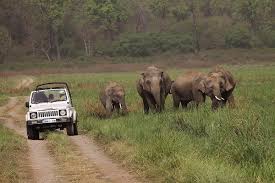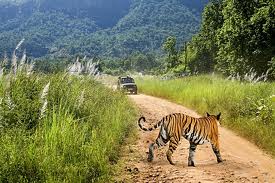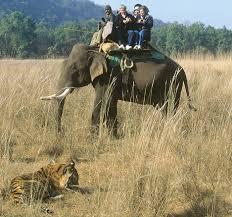|
Corbett National Park is India’s
first National Park. The Park was est ablished
in August 8, 1936, and named after the Governor of the United
Provinces, Sir Malcolm Hailey, as Hailey National Park. In 1952,
the Park’s name was changed to Ramganga National Park. In 1957,
the Park was renamed yet again, this time after Jim Corbett, the
famed hunter-author-photographer-naturalist. Jim Corbett is famous
for his exploits in the jungles of Nainital and Kumaon, where he
shot many man-eaters. The Man-eaters of Kumaon, The Temple Tiger
and The Man-eating Leopard of Rudraprayag are a few of Jim
Corbett’s famous books. On the road to Nainital from the Park is
Jim Corbett’s home, now a museum. ablished
in August 8, 1936, and named after the Governor of the United
Provinces, Sir Malcolm Hailey, as Hailey National Park. In 1952,
the Park’s name was changed to Ramganga National Park. In 1957,
the Park was renamed yet again, this time after Jim Corbett, the
famed hunter-author-photographer-naturalist. Jim Corbett is famous
for his exploits in the jungles of Nainital and Kumaon, where he
shot many man-eaters. The Man-eaters of Kumaon, The Temple Tiger
and The Man-eating Leopard of Rudraprayag are a few of Jim
Corbett’s famous books. On the road to Nainital from the Park is
Jim Corbett’s home, now a museum.
Situated in the north of Uttar Pradesh, in Nainital and Garhwal
districts, Corbett National Park was the venue from where Project
Tiger was launched on April 1, 1973. Project Tiger aimed at saving
the tiger from extinction because a census in 1970 revealed that
the tiger population had dwindled to 2,000, from 40,000 in 1913.
The Park is situated in the Himalayan fo othills,
amidst forested mountains that range from 400m (1,312ft) to 1,210m
(3,970ft) in height. Through most of the Park flows the Ramganga
River, on the banks of which lived a community in ancient times.
It is believed that these people cleared away a tiny part of the
forest, and made the area their home. Evidence in the form of
terracotta figurines and ruined temples further corroborate the
fact that the Ramganga valley was the home of an ancient
civilisation. othills,
amidst forested mountains that range from 400m (1,312ft) to 1,210m
(3,970ft) in height. Through most of the Park flows the Ramganga
River, on the banks of which lived a community in ancient times.
It is believed that these people cleared away a tiny part of the
forest, and made the area their home. Evidence in the form of
terracotta figurines and ruined temples further corroborate the
fact that the Ramganga valley was the home of an ancient
civilisation.
The best places to stay within the Park are at Dhikala, Gairal and
Bijrani. However, Dhikala is rather crowded with tourists. It is
advisable to stay in Gairal, which is quiet and offers excellent
sightings. A notice at Gairal (“Survivors will be prosecuted”)
warns against swimming in the Ramganga because of gharials (a
species of crocodile) that can kill human beings. Ramnagar, the
headquarters of Project Tiger, is also a good place to stay. Jeeps
can be hired from here for safaris into the Park, and
accommodation is better than at Dhikala and Gairal.
Flora
Corbett National Park is rich in vegetation, with different kinds
of tree s
and shrubs. The lower reaches of the Park, where the land is flat
compared to the upper reaches, consists of tall and slender sal (Shorea
robusta) trees. Shisham (Dalbergia sissoo) and khair (Acacia
katechu) trees are found in the middle reaches, while the upper
reaches of the mountains are full of bakli (Anogeissus latifolia),
chir (Pinus roxburghii), gurail (Bauhinia racemosa) and bamboo
trees. The Park is dotted with lantana shrubs, a species that is a
great cause for concern. Imported years ago from America, the
lantana shrub ensures that nothing else grows near it. In the Park
are 110 species of trees, 51 species of shrubs, and over 33
species of bamboo and grass that are mostly found in chowds, or
meadows. s
and shrubs. The lower reaches of the Park, where the land is flat
compared to the upper reaches, consists of tall and slender sal (Shorea
robusta) trees. Shisham (Dalbergia sissoo) and khair (Acacia
katechu) trees are found in the middle reaches, while the upper
reaches of the mountains are full of bakli (Anogeissus latifolia),
chir (Pinus roxburghii), gurail (Bauhinia racemosa) and bamboo
trees. The Park is dotted with lantana shrubs, a species that is a
great cause for concern. Imported years ago from America, the
lantana shrub ensures that nothing else grows near it. In the Park
are 110 species of trees, 51 species of shrubs, and over 33
species of bamboo and grass that are mostly found in chowds, or
meadows.
Fauna
Corbett National Park has more than 50 species of mammals, 585
species of birds and 25 species of reptiles, but the Park is known
for its elephants and leopards, not its tigers. Many kinds of
deer, namely chital (spotted deer), sambar (Indian stag), chinkara
(Indian gazelle), pada (hog deer) and muntjac (barking deer)
abound in the Park. Tiger sighting is rare, in spite of a lot of
alarm calls from monkeys and deer. Elephant herds comprising
tuskers, females and calves are commonly seen. However, an
elephant herd with calves is perhaps the most dangerous encounter
in the wild, for elephants are very possessive of their young and
do not hesitate to charge at intruding human beings.
Leopard sighting is even rar er
than that of the tiger, and these spotted cats confine themselves
to the higher reaches of the Park. Other feline species found in
the Park are leopard cats, jungle cats, the rare fishing cat, and
caracal, to name a few. Sloth bears, wild boars, monkeys, dholes
(wild dogs), jackals and ghorals (mountain goats) also inhabit the
Park. er
than that of the tiger, and these spotted cats confine themselves
to the higher reaches of the Park. Other feline species found in
the Park are leopard cats, jungle cats, the rare fishing cat, and
caracal, to name a few. Sloth bears, wild boars, monkeys, dholes
(wild dogs), jackals and ghorals (mountain goats) also inhabit the
Park.
The aquatic reptile population in the Park consists of mugger (Crocodylus
palustris) and gharial (Gavialis gangeticus) crocodiles, while
Indian rock pythons, Russell’s vipers, cobras, king cobras and
common kraits are some of the snakes found in the Park. Bird life
includes parakeets, flycatchers, babblers, cuckoos, robins,
bulbuls, Indian and Great Pied hornbills, warblers and finches, to
name a few.
Safaris
Elephant safaris can be arranged in Dhikala and Bijrani.
Jeep safaris are available from outside the Park as well as from
Dhikala. 86km from Nainital. |